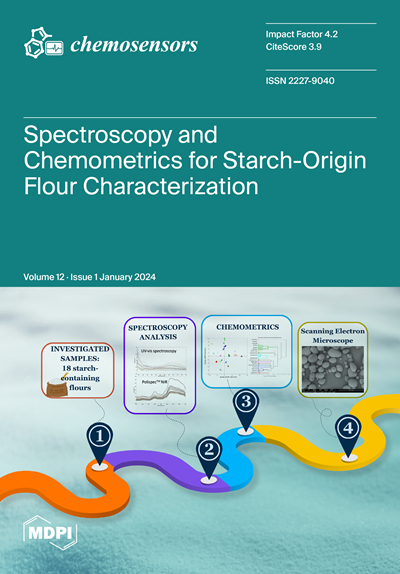Surface-Catalyzed Zinc Oxide Nanorods and Interconnected Tetrapods as Efficient Methane Gas Sensing Platforms
IF 3.7
3区 工程技术
Q2 CHEMISTRY, ANALYTICAL
引用次数: 0
Abstract
Nanostructured metal oxide semiconductors have proven to be promising for the gas sensing domain. However, there are challenges associated with the fabrication of high-performance, low-to-room-temperature operation sensors for methane and other gases, including hydrogen sulfide, carbon dioxide, and ammonia. The functional properties of these semiconducting oxides can be improved by altering the morphology, crystal size, shape, and topology. Zinc oxide (ZnO) is an attractive option for gas sensing, but the need for elevated operating temperatures has limited its practical use as a commercial gas sensor. In this work, we prepared ZnO nanorod (ZnO-NR) arrays and interconnected tetrapod ZnO (T-ZnO) network sensing platforms as chemiresistive methane sensors on silicon substrates with platinum interdigitated electrodes and systematically characterized their methane sensing response in addition to their structural and physical properties. We also conducted surface modification by photochemical-catalyzed palladium, Pd, and Pd-Ag alloy nanoparticles and compared the uniformly distributed Pd decoration versus arrayed dots. The sensing performance was assessed in terms of target gas response magnitude (RM) and response percentage (R) recorded by changes in electrical resistance upon exposure to varying methane concentration (100–10,000 ppm) under thermal (operating temperatures = 175, 200, 230 °C) and optical (UV A, 365 nm illumination) excitations alongside response/recovery times, and limit of detection quantification. Thin film sensing platforms based on T-ZnO exhibited the highest response at 200 °C (RM = 2.98; R = 66.4%) compared to ZnO-NR thin films at 230 °C (RM = 1.34; R = 25.5%), attributed to the interconnected network and effective bandgap and barrier height reduction of the T-ZnO. The Pd-Ag-catalyzed and Pd dot-catalyzed T-ZnO films had the fastest response and recovery rates at 200 °C and room temperature under UV excitation, due to the localized Pd nanoparticles dots resulting in nano Schottky barrier formation, as opposed to the films coated with uniformly distributed Pd nanoparticles. The experimental findings present morphological differences, identify various mechanistic aspects, and discern chemical pathways for methane sensing.表面催化氧化锌纳米棒和互联四足体作为高效甲烷气体传感平台
纳米结构的金属氧化物半导体在气体传感领域已经被证明是很有前途的。然而,制造用于甲烷和其他气体(包括硫化氢、二氧化碳和氨)的高性能、低至室温操作传感器存在挑战。这些半导体氧化物的功能特性可以通过改变形貌、晶体尺寸、形状和拓扑结构来改善。氧化锌(ZnO)是气体传感的一个有吸引力的选择,但需要提高工作温度限制了其作为商业气体传感器的实际应用。在本研究中,我们在硅衬底上制备了ZnO纳米棒(ZnO- nr)阵列和互连四足ZnO (T-ZnO)网络传感平台作为化学甲烷传感器,并系统地表征了它们的甲烷传感响应以及结构和物理性质。我们还通过光化学催化的钯、钯和钯银合金纳米颗粒进行了表面修饰,并比较了均匀分布的钯装饰和排列的点。在热(工作温度= 175、200、230°C)和光学(UV A, 365 nm照明)激励下,暴露于不同甲烷浓度(100-10,000 ppm)时,电阻的变化记录了目标气体响应幅度(RM)和响应百分比(R),以及响应/恢复时间和检测定量限。基于T-ZnO的薄膜传感平台在200℃时表现出最高的响应(RM = 2.98;R = 66.4%)与ZnO-NR薄膜相比,在230℃(RM = 1.34;R = 25.5%),这归因于T-ZnO的互连网络和有效的带隙和势垒高度降低。在200℃和室温下,钯银催化和钯点催化的T-ZnO薄膜的响应和回收率最快,这是由于局部的钯纳米粒子点形成了纳米肖特基势垒,而不是均匀分布的钯纳米粒子涂覆的薄膜。实验结果呈现形态差异,确定各种机制方面,并辨别甲烷传感的化学途径。
本文章由计算机程序翻译,如有差异,请以英文原文为准。
求助全文
约1分钟内获得全文
求助全文
来源期刊

Chemosensors
Chemistry-Analytical Chemistry
CiteScore
5.00
自引率
9.50%
发文量
450
审稿时长
11 weeks
期刊介绍:
Chemosensors (ISSN 2227-9040; CODEN: CHEMO9) is an international, scientific, open access journal on the science and technology of chemical sensors published quarterly online by MDPI.The journal is indexed in Scopus, SCIE (Web of Science), CAPlus / SciFinder, Inspec, Engineering Village and other databases.
 求助内容:
求助内容: 应助结果提醒方式:
应助结果提醒方式:


